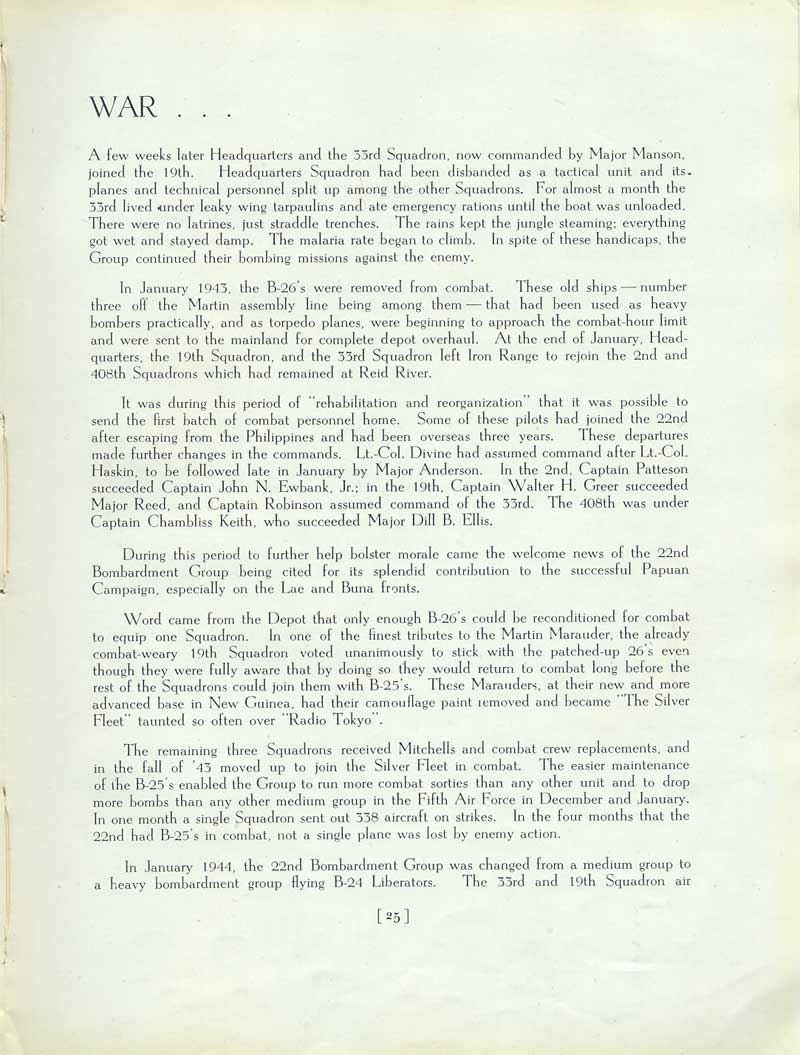
Next page...

| WAR ... A few weeks later Headquarters and the 33rd Squadron, now commanded by Major Manson, joined the 19th. Headquarters Squadron had been disbanded as a tactical unit and its planes and technical personnel split up among the other Squadrons. For almost a month the 33rd lived under leaky wing tarpaulins and ate emergency rations until the boat was unloaded. There were no latrines, just straddle trenches. The rains kept the jungle steaming; everything got wet and stayed damp. The malaria rate began to climb. In spite of these handicaps, the Group continued their bombing missions against the enemy. In January 1943, the B-26's were removed from combat. These old ships - number three off the Martin assembly fine being among them - that had been used as heavy bombers practically, and as torpedo planes, were beginning to approach the combat-hour limit and were sent to the mainland for complete depot overhaul. At the end of January, Headquarters, the 19th Squadron, and the 33rd Squadron left Iron Range to rejoin the 2nd and 408th Squadrons which had remained at Reid River. It was during this period of "rehabilitation and reorganization" that it was possible to send the first batch of combat personnel home. Some of these pilots had joined the 22nd after escaping from the Philippines and had been overseas three years. These departures made further changes in the commands. Lt.-Col. Divine had assumed command after Lt.-Col. Haskin, to be followed late in January by Major Anderson. In the 2nd, Captain Patteson succeeded Captain John N. Ewbank, Jr.; in the 19th, Captain Walter H. Greer succeeded Major Reed, and Captain Robinson assumed command of the 33rd. The 408th was under Captain Chambliss Keith, who succeeded Major Dill B. Ellis. During this period to further help bolster morale carne the welcome news of the 22nd Bombardment Group being cited for its splendid contribution to the successful Papuan Campaign, especially on the Lae and Buna fronts. Word came from the Depot that only enough B-26's could be reconditioned for combat to equip one Squadron. In one of the finest tributes to the Martin Marauder, the already combat-weary 19th Squadron voted unanimously to stick with the patched-up 26's even though they were fully aware that by doing so they would return to combat long before the rest of the Squadrons could join them with B-25's. These Marauders, at their new and more advanced base in New Guinea, had their camouflage paint removed and became "The Silver Fleet" taunted so often over "Radio Tokyo". The remaining three Squadrons received Mitchells and combat crew replacements, and in the fall of '43 moved up to join the Silver Fleet in combat. The easier maintenance of the B-25's enabled the Group to run more combat sorties than any other unit and to drop more bombs than any other medium group in the Fifth Air Force in December and January. In one month a single Squadron sent out 338 aircraft on strikes. In the four months that the 22nd had B-25's in combat, not a single plane was lost by enemy action. In January 1944, the 22nd Bombardment Group was changed from a medium group to a heavy bombardment group flying B-24 Liberators. The 33rd and 19th Squadron air |